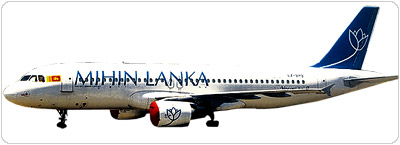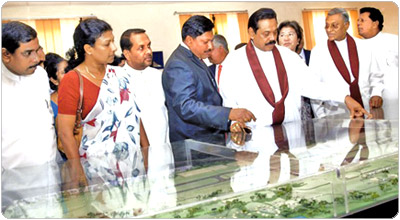Sri Lanka flies high
By Shirajiv SIRIMANE

It was in 1934 that a decision was first taken
to construct an aerodrome close to Colombo, and Ratmalana was selected
as the best site. One year later a de Havilland Puss Moth flown by a
pilot attached to the Madras Flying Club landed at this airport,
launching the aviation industry in the country. Ratmalana was Sri
Lanka's only international airport until the Bandaranaike International
Airport was opened in the 1960s. From this day all air travel took place
from Colombo. A second international airport was a very important piece
of infrastructure needed by the country.
|

President Mahinda Rajapaksa inspecting a model of the
Mattala airport |
|
More
airlines want
to include Sri Lanka
in their international
route map while
many others want to
add additional
frequencies. However,
heavy traffic at the
Colombo airport
was a drawback to
these plans. |
Airlines flying to Sri Lanka today are compelled to carry additional
backup fuel in case they have to divert. Due to this reason, flying to
Sri Lanka is considered a costly affair and some airlines have even gone
to the extent of adding this additional expenditure to the passengers'
tickets.
More airlines want to include Sri Lanka in their international route
map while many others want to add additional frequencies. However, heavy
traffic at the Colombo airport was a drawback to these plans.
With five international harbours simultaneously being developed in
line with the Mahinda Chinthana Sri Lanka is slowly but surely
transforming itself to become a maritime hub for the region. Sri Lanka
also needs to rapidly develop its status as an aviation hub, for which a
second international airport became a priority.
This long overdue second international airport too had been discussed
for nearly two decades with Hingurakgoda, Matugama, Wellawaya and most
recently Weerawila receiving the spotlight as possible sites.
After carrying out many feasibility studies, Weerawila in Hambantota
was selected as the venue to transform this dream to reality.
However, heeding to the requests of farmers and environmentalists,
the venue was shifted to Mattala as there was no need to relocate a
single family if this venue was selected. "This is a responsible
government and we do things for the welfare and future prosperity of the
people and this was the reason for us to relocate from Weerawila to
Mattala," said Chairman, Airport and Aviation Services, Prasanna
Wickramasuriya.
The Hambantota International Airport would be the cynosure of all
eyes when it becomes one of the most speedily completed airports in the
world aviation history with the scheduled opening by end 2012.
Construction began on November 27 last year. The investment is US$
209 million, with funding from the China Exim Bank.
Financial assistance
The Chinese government provides financial assistance and technical
know-how for this much needed-project.
A container yard, warehouse facilities and an industrial park too
would be built nearby so that it could serve both the airport and the
Hambantota harbour which is located just 32 km from the site.
The first stage would include Sri Lanka's longest runway (3500m) and
parking bay for 10 aircraft, two aerobridges and other buildings.
Meanwhile, the Bandaranaike International Airport is also undergoing
a major transformation.
A new terminal, hotel and other infrastructure would be built while
it would also be connected to the proposed Colombo-Katunayake highway.
Train services too would be linked to the airport, taking the
passengers even faster to Colombo.
Under the Mahinda Chinthana program, regional airports too would be
developed with the main objective of enabling a passenger to cover the
entire island by air.
Ampara, Palali and Trincomalee domestic airports are being developed
with regular scheduled flights already operating. "Sri Lanka has 14
domestic airports and all these would be developed," he said.
Plans are under way to convert the Ratmalana airport to a city
airport, like the City Airport in London.
The Government also granted permission to recommence sea plane
operations and this will be a major attraction for tourism.
In addition to the acquisition of more aircraft to the national
carrier SriLankan Airlines, its route network too has been expanded.
The budget airline Mihin Lanka too is making great strides, flying to
more new destinations such as Jakarta, Dhaka and the Male.
Connectivity is one of the most important points an entrepreneur
would look for when investing in any country and with the rapid
development in this sphere no investor would have second thoughts on
investing in Sri Lanka. |

